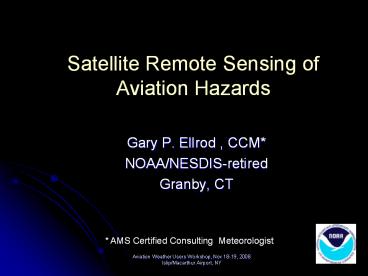Satellite Remote Sensing of Aviation Hazards - PowerPoint PPT Presentation
1 / 37
Title: Satellite Remote Sensing of Aviation Hazards
1
Satellite Remote Sensing of Aviation Hazards
- Gary P. Ellrod , CCM
- NOAA/NESDIS-retired
- Granby, CT
AMS Certified Consulting Meteorologist
2
Outline
- Current capabilities of satellite data
- Fog and low clouds
- Inflight icing
- Turbulence
- Thunderstorms (initiation, convective gusts)
- Volcanic ash
- Future improvements (GOES-R)
3
U.S. Weather Satellites
- Polar (low orbit) (NOAA-18 / METOP-A)
- 1 km resolution
- 4 looks per day
- 6 channels
- Geostationary (GOES-11/12)
- 4 km IR, 1 km visible
- 15-30 min frequency
- 5 channel Imager
- 19 channel Sounder (10 km), hourly over CONUS
4
Nighttime Fog Detection Using GOES
Multi-spectral Image Data
5
Fog in the Northeast 14 June 2001
6
GOES Low Cloud Base Product
- Based on GOES 11mm-3.9 mm and surface minus GOES
cloud top temperatures (now available on AWIPS)
Red areas show where cloud bases lt1000 ft are
likely, green areas gt 1000 ft, blue are cirrus
clouds.
7
Fog Depth Estimates
- Estimates of fog depth also possible based on
11mm-3.9 mm temperature difference (to forecast
burn off time)
8
Snow and Fog Using Visible Imagery
Snow
Snow
9
Fog Discrimination with 3.9mm Imagery
10
GOES Icing Risk Product
- Multi-channel threshold technique
- Merged with Sounder cloud top heights
- Product available hourly day and night
- Strengths
- Good spatial, temporal coverage
- Good POD (50-75), low FAR (25)
- Weaknesses
- Obscuration by high clouds
- Unable to distinguish SLD regions
11
GOES Combined Icing Cloud Tops
(ICECAP)Available at http//www.star.nesdis.no
aa.gov/smcd/opdb/aviation/icg.html
Icing intensity (3mod, 4mod/sev), aircraft
type, altitude (feet)
12
GOES Water Vapor IR Winds
13
Detection of Mountain Waves Using Water Vapor
Imagery
Low and mid-Tropospherice waves can be seen in
GOES 6.7 mm water Vapor imagery, but not in IR
or visible
14
Total Column Ozone from GOES Sounder
Stratospheric Intrusion
15
Convective Initiation
- Critical for air traffic management
- GOES Visible Imagery Applications (boundary
interactions, stability, etc) - Stability and moisture Products from Sounder
(Lifted Index, PW, Cinh) - Automated Nowcast Products
- Convective Initiation (UW-CIMSS and U. of
Alabama-Huntsville)
16
Convective Initiation (CI) Product(U. of
Ala-Huntsvile/ U. of Wisconsin CIMSS)
- Uses satellite parameters to identify convective
clouds - IR temp. change
- WV - IR temp. difference
- Cloud motion vectors to advect developing clouds,
produce nowcast
CI valid 2000Z, 4 May 2003
Radar, 2100Z, 4 May 2003
17
Wet Microburst Severity Index
- Uses GOES Sounder retrieval data
- Based on instability and vertical distribution of
moisture (CAPE, d?e/dz) - Correlates well with observed peak surface wind
gusts
WMSI gt 200 indicates wind gusts gt 65 knots
possible. 85 knot gusts were reported at
Patuxent River, Maryland at 2100 UTC ().
18
Composite Split Window ImageryMt. Spurr, Sept.
1992, NOAA-AVHRR
(Schneider et al 1992)
19
International Warning System (VAACs)
Established by International Civil Aeronautical
Organization (ICAO) in mid-1990s Volcanically
active regions source Smithsonian Inst.
20
Technology OutlookOperational Spacecraft
- Near-Term
- GOES-N (launched May 2006) through P
- Improved navigation, power to operate through
satellite eclipse (Spring, Fall) - Mid-Long Term
- NPOESS VIIRS imager (NPP prototype launch in
2010) - Twenty-two bands at 370 to 740 m resolution
- Includes day/night visible
21
Technology OutlookOperational Spacecraft
- Long-Term
- GOES-R Advanced Baseline Imager (2015)
- Sixteen spectral bands
- Resolution 0.5 km visible, 2 km IR
- Five minute CONUS, 15 min Full Disk
- GOES-R Lightning Mapper
- GOES Hyper-spectral Sounder - ????
- Hyper-spectral capabilities, hourly global
coverage - Good resolution (4 km horizontal, 1 km vertical)
22
ABI Improvements
5 Minute Coverage
ABI covers the earth approximately five times
faster than the current Imager.
23
Imager Coverage in 30 minutes
Current Imager (Rapid Scan mode) Future Imager (Flex mode)
Full Disk 0 2
Northern Hemi 1 -
CONUS 3 6
Mesoscale 0 60
Full Disk
N. Hemisphere
CONUS
Mesoscale
24
IR Resolution ABI versus GOES-12
25
Use of 1.6 mm Near-IR on ABI
1.6 mm
26
Simulated GOES-R Fog ImageBased on AVHRR IR (3.7
mm and 11.0 mm)
27
GOES-R Icing Product (NASA LARC)
Explicit parameters from GOES (droplet size,
liquid Water path) can estimate Potential icing
severity
28
Simulated Water Vapor Imagery (Low, Mid, High) on
ABI
29
Automated Turbulence Detection GOES-R Water
Vapor(U. of Wisconsin CIMSS)
30
Simulated GOES-R Ash ImageBased on MODIS IR,
Near-IR, Visible Channels
- Volcanic ash (red)
- Composite of 8.5, 11, 12mm channels
- Land (green)
- Near-IR (1.6mm)
- Ocean/ice clouds (blue)
- Visible (0.6mm)
Popocatepetl, 20 Dec 2000, 1715 UTC Based on data
from Terra MODIS
31
Geostationary Lightning Mapper (GLM)
- Detects total strikes in cloud, cloud to
- Day/night total lightning (in cloud, intra-cloud,
and cloud to ground) - Compliments todays land based systems that only
measures cloud to ground (about 15 of the total
lightning) - Increased coverage over oceans and land
- Currently no ocean coverage, and limited land
coverage in dead zones
32
Example from Lightning Imaging Sensor (LIS)
33
Simulations of Low vs High Spectral Resolution
Retrievals Geo-I gets lt1 K rms for 1 km T(p) and
lt10 rms for 2 km RH(p)
34
Capability Vertical Profiling
BT(K)
Analysis courtesy of Jun Li, CIMSS.
35
Summary
- Satellite remote sensing is critical in providing
needed observations to support aviation warnings
and forecasts - Future instruments will provide excellent
opportunities for improved products - Much work is needed to fully utilize future
deluge of high quality data!
36
Internet Resources
- GOES Aviation Products (Imager and Sounder)
- http//www.star.nesdis.noaa.gov/smcd/opdb/aviation
/ (NESDIS) - http//weather.msfc.nasa.gov/goesprod/ (NASA
GHCC) - http//www.nrlmry.navy.mil/NEXSAT.html
(NRL-Monterey) - GOES-R Information
- http//www.goes-r.gov/ (GOES Program Office)
- http//cimss.ssec.wisc.edu/goes_r/ (UW-CIMSS)
37
Acknowledgments
- Slides obtained from
- Brian Motta (COMET)
- Ken Pryor (NESDIS)
- Tim Schmit (NESDIS)
- William Smith, Jr. (NASA)
- Anthony Wimmers (UW-CIMSS)
- Kris Bedka (UW-CIMSS)































